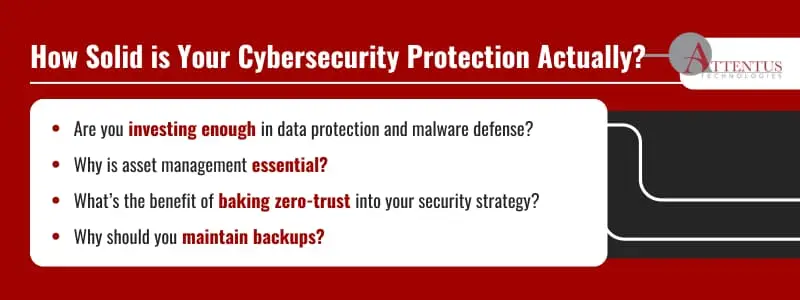With adversaries showing no signs of slowing down, business owners would do well to level up their defenses. Here are four simple data protection measures you can implement today.

Are your cybersecurity protection measures adequate to fend off modern attacks?
Threats are increasing and evolving faster than many businesses can keep up. According to Check Point’s 2025 security report, incidents surged 44% in 2024 globally. Malware attacks increased 58% year-over-year, with adversaries exploiting VPNs, routers, and other edge devices as an initial access vector. And artificial intelligence (AI) powered attacks are also trending upwards.
McKinsey says generative AI (GenAI) platforms have accelerated phishing attacks by 1,265% in the last three years. That’s pretty worrisome.
With cloud, AI, and remote work adoption rising, data flows, endpoints, and the human element remain attractive targets. Time to go back to the drawing board? Probably. SMBs need advanced tools, strategies, and trusted partnerships to fortify their defenses now more than ever.
Here’s what to know about the four key measures to protect your business from increasing cyber threats.
1. Invest in Employee Training and Threat Intelligence
Adversaries will likely attempt to compromise your organization by powering phishing attacks with GenAI. These typically involve highly convincing emails and deepfakes to trick your team into revealing sensitive information. The best way around this is to train your team to recognize and respond to such attempts effectively.
But does that alone keep your business safe? Not quite. Adversaries now use machine learning to evolve malicious code in real-time and avoid static detection. They can deploy malware that adapts to your endpoint defenses. If you use siloed security tools to manage endpoints, you could find it challenging to keep up.
Isn’t it time to ditch manual threat hunting in favor of advanced anomaly detection? A robust extended detection and response (XDR) solution with AI at the core can unify your security, allowing for faster and more precise investigation, threat hunting, and response.
2. Secure Your Edge Devices
You close your physical doors and windows. But what about your virtual ones?
Pause for a moment and think about your current technology ecosystem. You likely use CCTV to monitor the premises and a router that connects to your internet service provider (ISP) and then to the Internet. Many IoT devices such as laptops, tablets, and mobile phones are connected to your network. These are all virtual doors and windows through which adversaries can enter and steal information for financial gain.
It’s vital to understand your organization’s assets:
- When’s the last time you patched or updated your technology assets?
- Do you know what needs upgrading and when?
- What’s your BYOD policy?
- What technology and information is within the organization?
- Do you really need it? (Remember, the more assets you hold, the greater the attack surface.)
- Where do vulnerabilities lie?
- What’s outdated or nearing its end of life (EOL)?
Applying and maintaining proportionate security controls becomes much more manageable once you know which assets are connected to your network. Plus, knowing which costs are coming up and when improves your ability to plan for future technology cycles.
3. Implement Strong Passwords, MFA, Access Controls, and Encryption
Do any of your employees use 123456 or their birthday as passwords? Do they use similar credentials across accounts?
Your organization is at serious risk. You must establish a solid policy outlining best practices for password use and management immediately. Ideally, your employees should use passwords with at least nine characters (combining letters, numbers, and symbols).
An example of a strong password is: Ewg@A5~UtwVJ8*$
Such a password would take over a century to crack with current computing capabilities, but one containing a birth date or any other short numeric code can be compromised in seconds. Additionally, multi-factor authentication can be used as an extra verification step to prevent hackers from entering the gates.
What if they still manage to get in? That’s where access control and data encryption come into play.
As a rule, employees should be given only the access required to perform their jobs without friction. This protects against insider and outsider threats by restricting lateral movement across the organization using one account. Encrypting data also makes it useless to adversaries if they don’t possess the decryption keys.
When used in tandem, these measures considerably minimize the impact of a breach and create the foundation for zero-trust security.
4. Back Up Your Data
While solid data protection and malware defense measures can elevate your organization’s security posture, no strategy is foolproof. Maintaining regular data backups as an insurance policy is crucial if the worst happens.
A good rule of thumb is to store three data copies on two device types and one off-site location. This is known as the 3-2-1 backup strategy, and it helps establish redundancy in case of compromise to the original data in your primary location.
Remember, backups should be tested regularly to ensure data is recoverable when needed.
Attentus Technologies’ Cybersecurity Protection Can Give You an Edge
Need help with data protection?
Attentus Technologies can deliver comprehensive managed security services, honed by more than 20 years of experience. We use advanced intelligence tools to monitor your technology estate and safeguard your prized assets continuously. Our backup disaster recovery (BDR) solution keeps your data recoverable and instantly reroutable should any incident impact your primary storage location or devices.
We help you grow your business with peace of mind, knowing that a reliable partner has your back.
Curious about what the Attentus advantage means for you? Let’s chat! Schedule a custom consultation today.
